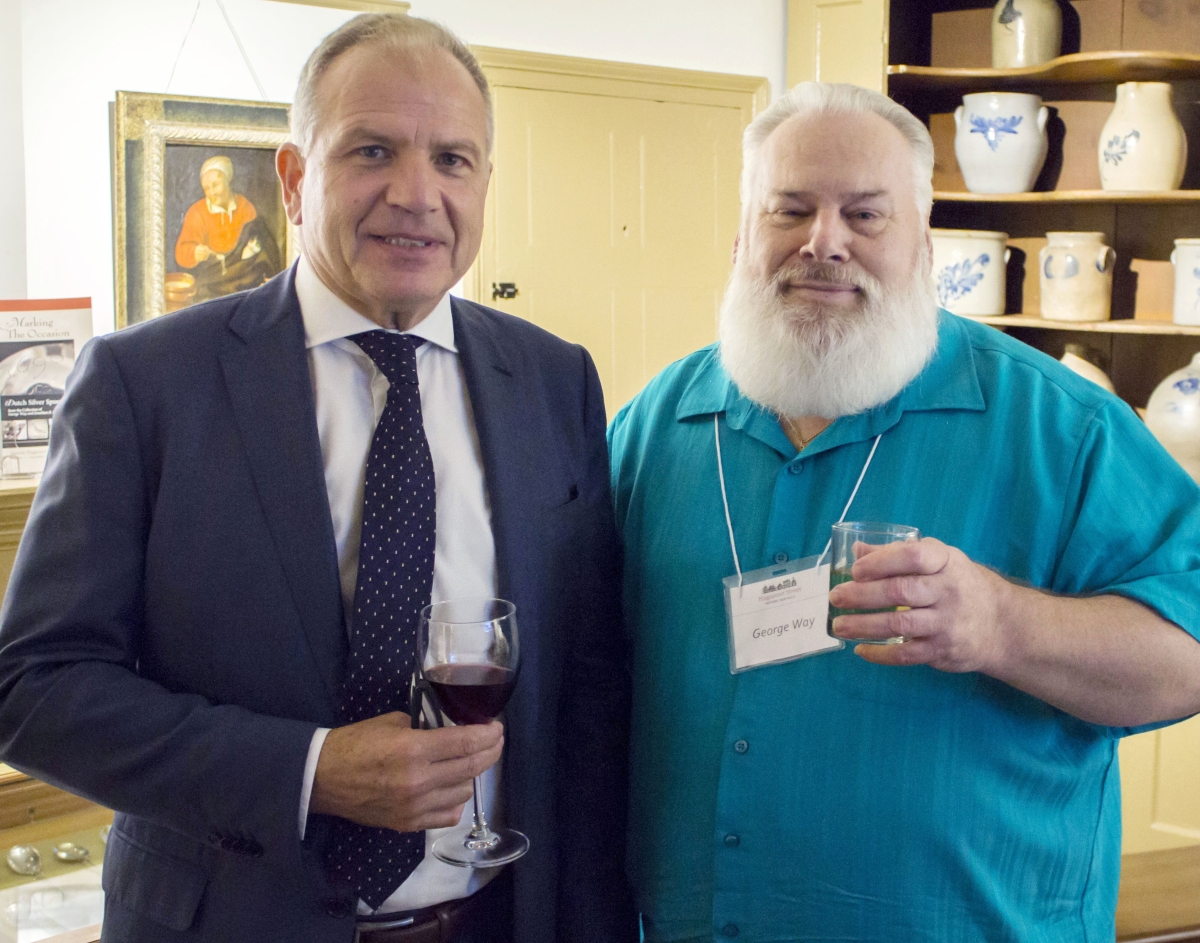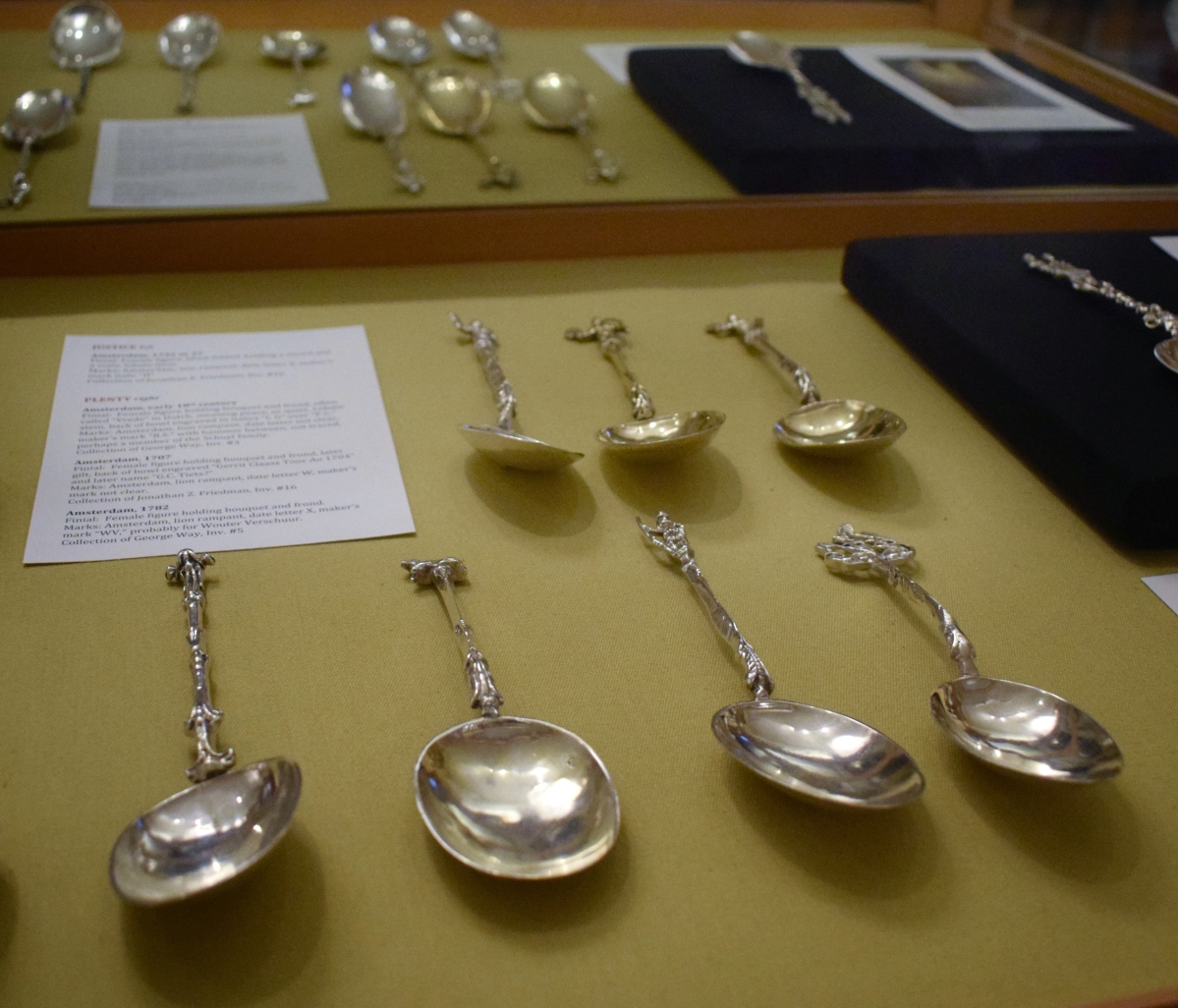
George Way, right, stands with the recently appointed consul general of the Kingdom of the Netherlands, the Honorable Dolf Hogewoning, who visited the exhibit at Historic Huguenot Street in October.
A collector since age 15, George Way’s interest quickly became a passion as he was drawn in to the golden age of Dutch culture. From a novice to connoisseur, his collection has grown to become one of America’s foremost collections of Sixteenth–Seventeenth Century Dutch and English furniture, paintings and decorative objects. He writes and lectures on Seventeenth Century Dutch antiques and furniture and was named one of the top 100 collectors in America by Art & Antiques Magazine for four years running, 1989–92. His collection of Dutch silver spoons was recently featured at Historic Huguenot Street in New Paltz, N.Y.
Why and when did you start collecting silver? What was the first piece you purchased?
My interest in early silver oddly enough came later in my 52 years of collecting. I was not interested in silver at such an early date since I was mainly focused on Sixteenth–Seventeenth Centuries. I spent most of my time roaming the floors of the period rooms at the Metropolitan Museum of Art, so much, in fact, that the guards were even helpful by turning pieces over for me so I could get a closer look at construction as well as the types of woods used in their manufacturing.
My first period piece of silver was a Charles II silver plate with a decorated repoussé border that I discovered in a shop some 32 years ago. After training my eyes for so many years to recognize silver from those pieces displayed at the Metropolitan Museum, I knew I finally discovered my first early piece of period silver. The owner was unaware of its actual age even though it had no hallmarks to identify the maker. Based on the age and the ware as well as its floral decoration I knew it was the real deal. Soon after I paid more attention to searching for period silver and came upon various spoons while attending many antique shows and flea markets.
What makes Dutch spoons so interesting?
For starters, there are very little, if any, spoons from America for sale and if one does comes up, it will cost thousands of dollars. I love and admire Dutch spoons because they do remind me of those that were also made in the Colonies. Most, if not all, were Dutch silversmiths who migrated to America and their ideas in the way of design found their way onto American silver. It is not difficult to tell those spoons which are Dutch solely on the makers’ marks. American silver only has one set of initials to identify the makers such as “IB” which indicates it was made by Jurian Blanck Jr, 1645–1715. This spoon and others are actually prototypes of those made back in the Netherlands. Dutch spoons have four hallmarks, which will indicate where it was made, the years of manufacture, the maker and silver standard. The main reason I enjoy collecting Dutch spoons is because they are available on occasion and they all exhibit such interesting finials that we do not find on American examples.
What’s the most fascinating or storied piece in your collection and why?
I could go on forever with this question since I have hundreds of great and interesting stories as I have been collecting for over 50 years. One is bound to come upon rare and important things while on the hunt; however, it is those few who have developed the eye to detect the rare and one-of-a-kind pieces that are waiting for you to rescue. One of my most important pieces of furniture —and there are many — is an English court cupboard dating to the time of Elizabeth I. I came upon this magnificent piece in an antiques store in Greenwich Village more than 30 years ago. It was in a storage area above the dealer’s shop, rooms filled with all sorts of furniture and I almost fell over since cupboards like this rarely leave England. It displayed large carved bulbous supports and was richly carved from top to bottom, it even had its original locks and keys, which is almost unheard of. After careful examination, I realized it was completely original meaning no restoration of any kind.
I ran down the stairs to ask the dealer how much he was asking for it and he could not remember which piece I was referring too. Once upstairs, he told me if I could get it out within a few days I could have it for $900. If he would have said $20,000, I still would have bought it, so I paid him immediately. This is one of the finest cupboards I have ever seen and I wonder to this day which important house this might have come out of in England.
What else do you collect?
I collect English and Dutch furniture and Old Master paintings from the Sixteenth–Seventeenth Centuries. I also collect early brass items, i.e., candlesticks, fireplace tools, basins, pewter plates, miniature portraits on copper, mainly Dutch; early iron, Seventeenth Century drawings and etchings. I ran out of room, unable to hang another artwork, but that does not stop me. It is difficult to pass up bargains when you see them, if you do you might regret it.
Are you planning anything for the future?
I plan on putting together a period Seventeenth Century Dutch room in one of the period houses at New Paltz [N.Y.], hopefully in the fall of 2017. This will include period paintings, etchings, furniture, decorative objects and, of course, a period fireplace. I am also going to be doing a major show at the Albany Institute of Art in Albany in 2018. Keeping busy, which I like. Getting up in years, so it is nice there is now so much interest in my collection.
—Andrea Valluzzo





